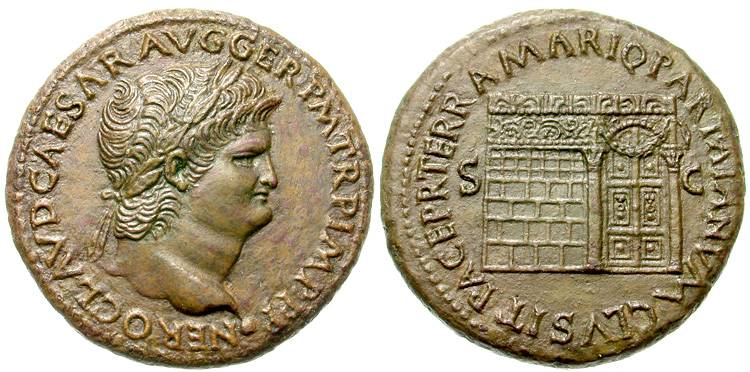Lot 65: NERO. 54-68 AD. Æ Sestertius. Lugdunum mint. Struck 65 AD. 
AUCTION: Sale 220

- Sold Winning Bid: $3,000
- 11 Bid(s)
NERO. 54-68 AD. Æ Sestertius (35mm - 25.27 g). Lugdunum mint. Struck 65 AD. NERO CLAVD CAESAR AVG GER P M TR P IMP P P P, laureate head right, small globe at point of bust / PACE P R TERRA MARIQ PARTA IANVM CLVSIT, S-C across field, temple of Janus with latticed window to left, garland hung across closed double doors on right. RIC I 438; BMCRE 319; WCN 419. EF, brown patina, well struck with very little wear.
At first glance I thought that this coin had been pretty heavily worked, but upon closer inspection under a scope and after talking with the person who did the cleaning, I've changed my mind. The coin has been painstakingly cleaned of encrustations and deposits, trying not to break the original brown patina. Under a glass are some natural red deposits that may have been smoothed slightly and a few small breaks in the thick brown patina. The coin has then been sealed in a wax like substance, which when rubbed with a toothpick actually rubs off. According to the cleaner, " The entire surface has been sealed under vacuum with a museum quality conservation coating to stabilize and strengthen the patina and prevent any possibility of a bronze disease break out - in short the coin is as well conserved as any museum specimen so will not deteriorate and will keep its value ." Under a scope there are no signs of tooling and what I though was smoothing in the fields is actually the stroke marks in the waxy sealant.
Fortunately, I was able to locate another coin from the same dies with which to compare it against (see Bank Leu 10, 29 May 1974, lot 77). Comparisons of the obverse show no tooling or addition of any details. The reverses though are slightly different, though the spacing of the letters shows that they are from the same dies. Both coins show the same ornate scroll work above the windows, and both show the same heavy wreath hung above the doors. The brick work on this specimen is well defined and the panels in the doors are ornately engraved, whereas the Leu specimen shows very little detail in these areas. We are then left with a few possibilities regarding the reverse of this coin. 1 - this coin has been tooled, although even under a scope I see now signs of metal movement or tooling. 2 - The Leu coin had been smoothed, removing some of the details. 3 - The Leu coin had a thick patina which obscured some of the finer details or 4 - The dies were altered, either adding more details to an unfinished reverse, or the fine details began to wear off the dies.
Overall this is a well struck and attractive specimen with a choice portrait. Unfortunately to the naked eye it looks like it's been messed with a bit, although under a scope it looks perfectly natural. It's one of the few coins I've handled that actually looks better under a scope than with the naked eye.
- Offered By: VAuctions
- Lot #: 65
- Listing #: 210180
- Closed: Thursday, January 22, 2009 6:08:00 PM CT
- Estimate: $3,000

